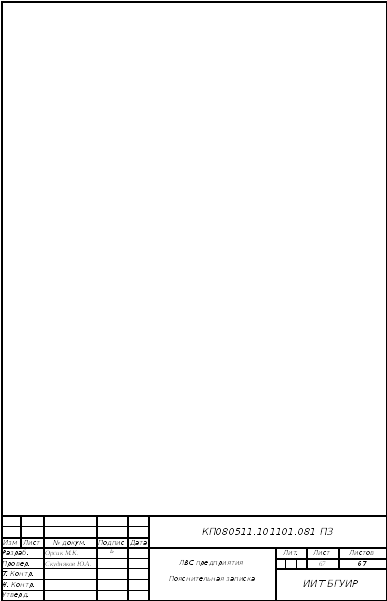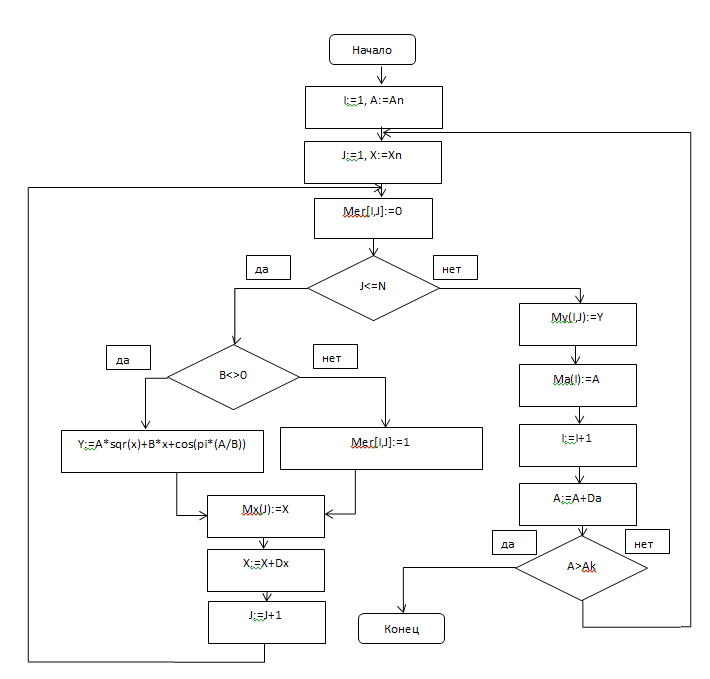
- •Учреждение образования
- •Введение
- •1 Анализ инфраструктуры предприятия
- •2 Разработка задания на проектирование лвс
- •3 Анализ условия размещения компьютеров и другого оборудования в помещениях предприятия
- •4 Расчет конфигурации сети
- •5 Анализ условий размещения физической среды в помещениях предприятия и между ними
- •6 Составление структуры физической среды сети, выбор кабеля
- •6.1 Выбор типа кабеля для горизонтальных подсистем
- •6.2 Структура горизонтальной кабельной подсистемы
- •6.8 Выбор типа кабеля с точки зрения секретности передаваемой информации
- •7.2 Выбор типовых сетевых репитеров
- •7.3 Выбор типовых сетевых коммутаторов
- •7.4 Выбор типов концентраторов
- •8 Выбор пассивного оборудования
- •9 Выбор компьютеров и другого оборудования
- •9.1 Выбор компьютеров и другого оборудования в зависимости от требований производительности и запоминающих возможностей
- •10 Выбор сетевой операционной системы
- •11 Выбор протоколов сети
- •12 Методы передачи данных в сети
- •13 Составление группового программного обеспечения
- •14 Методы и средства защиты информации в сети
- •Заключение
- •Список использованных источников
Заключение
В данном курсовом проекте согласно техническому заданию была спроектирована информационно-вычислительная сеть. Перед проектированием сначала было определенно количество узлов сети и способы их связи между собой и источниками информации, а так же параметры и места размещения каналов связи и т.п.
Выбор структуры при проектировании основывался на том, чтобы обеспечить оптимальную топологическую структуру по всем критериям, хотя самым главным критерием оптимизации в моем курсовом проекте являлась стоимость сети.
В ходе проделанной работы были выбраны: сетевое оборудование, среды передачи данных, конфигурации рабочих станций и серверов сети, сетевые протоколы, сетевая операционная система; размещение сетевого оборудования в учебных корпусах. Были рассмотрены такие: важные и интересные вопросы, как удаленный доступ к сети, подключение локальных информационных систем к глобальным сетям типа Internet.
Список использованных источников
«Компьютерные сети. Принципы, технологии, протоколы.» /Олифер, В.Г., Олифер, Н.А./ СПб.:Питер, 2002.-384c.
«Компьютерные сети» /Танненбаум, Э./ – СПб.:Питер, 2002. – 459c.
«Защита компьютерной информации». /Анин, Б./ – СПб.: БЧВ, 2000. -384c.
«Вычислительные системы, сети и телекоммуникации.» /Пятибратов, М.Д./ – ФИС, 1998. – 279с.
«TCP/IP. Архитектура, протоколы, реализация.» /Фейт, С., Лори, М./ СПб : БЧВ, 2000. – 562с.
«Сети ЭВМ: протоколы, стандарты, интерфейсы.» /Блэк, Ю./ М.: Мир, 1990. – 321с.
«Стандарты по локальным вычислительным сетям: Справочник» /Под ред. Шерба, В.К., Киреичев, В.М., Самойленко, С.И./ М.: Радио и связь, 1990 – 356c.
«Проектирование распределенных информационно-вычислительных систем.» / Решетняк, В.Н., Гузик, В.Ф., Сидоренко, В.Г./ Учеб. пособие. Таганрог: ТРТУ, 1996. – 284c.
Приложение А – Листинг программы
Исходные коды
//---------------------------------------------------------------------------
using System;
using System.Collections.Generic;
using System.ComponentModel;
using System.Data;
using System.Drawing;
using System.Text;
using System.Windows.Forms;
using Microsoft.DirectX.DirectSound;
using System.IO;
using System.Threading;
using System.Net.Sockets;
using System.Net;
using g711audio;
namespace VoiceChat
{
public partial class VoiceChat : Form
{
private CaptureBufferDescription captureBufferDescription;
private AutoResetEvent autoResetEvent;
private Notify notify;
private WaveFormat waveFormat;
private Capture capture;
private int bufferSize;
private CaptureBuffer captureBuffer;
private UdpClient udpClient; //Listens and sends data on port 1550, used in synchronous mode.
private Device device;
private SecondaryBuffer playbackBuffer;
private BufferDescription playbackBufferDescription;
private Socket clientSocket;
private bool bStop; //Flag to end the Start and Receive threads.
private IPEndPoint otherPartyIP; //IP of party we want to make a call.
private EndPoint otherPartyEP;
private volatile bool bIsCallActive; //Tells whether we have an active call.
private Vocoder vocoder;
private byte[] byteData = new byte[1024]; //Buffer to store the data received.
private volatile int nUdpClientFlag; //Flag used to close the udpClient socket.
public VoiceChat()
{
InitializeComponent();
Initialize();
}
/*
* Initializes all the data members.
*/
private void Initialize()
{
try
{
device = new Device();
device.SetCooperativeLevel(this, CooperativeLevel.Normal);
CaptureDevicesCollection captureDeviceCollection = new CaptureDevicesCollection();
DeviceInformation deviceInfo = captureDeviceCollection[0];
capture = new Capture(deviceInfo.DriverGuid);
short channels = 1; //Stereo.
short bitsPerSample = 16; //16Bit, alternatively use 8Bits.
int samplesPerSecond = 22050; //11KHz use 11025 , 22KHz use 22050, 44KHz use 44100 etc.
//Set up the wave format to be captured.
waveFormat = new WaveFormat();
waveFormat.Channels = channels;
waveFormat.FormatTag = WaveFormatTag.Pcm;
waveFormat.SamplesPerSecond = samplesPerSecond;
waveFormat.BitsPerSample = bitsPerSample;
waveFormat.BlockAlign = (short)(channels * (bitsPerSample / (short)8));
waveFormat.AverageBytesPerSecond = waveFormat.BlockAlign * samplesPerSecond;
captureBufferDescription = new CaptureBufferDescription();
captureBufferDescription.BufferBytes = waveFormat.AverageBytesPerSecond / 5;//approx 200 milliseconds of PCM data.
captureBufferDescription.Format = waveFormat;
playbackBufferDescription = new BufferDescription();
playbackBufferDescription.BufferBytes = waveFormat.AverageBytesPerSecond / 5;
playbackBufferDescription.Format = waveFormat;
playbackBuffer = new SecondaryBuffer(playbackBufferDescription, device);
bufferSize = captureBufferDescription.BufferBytes;
bIsCallActive = false;
nUdpClientFlag = 0;
//Using UDP sockets
clientSocket = new Socket(AddressFamily.InterNetwork, SocketType.Dgram, ProtocolType.Udp);
EndPoint ourEP = new IPEndPoint(IPAddress.Any, 1450);
//Listen asynchronously on port 1450 for coming messages (Invite, Bye, etc).
clientSocket.Bind(ourEP);
//Receive data from any IP.
EndPoint remoteEP = (EndPoint)(new IPEndPoint(IPAddress.Any, 0));
byteData = new byte[1024];
//Receive data asynchornously.
clientSocket.BeginReceiveFrom(byteData,
0, byteData.Length,
SocketFlags.None,
ref remoteEP,
new AsyncCallback(OnReceive),
null);
}
catch (Exception ex)
{
MessageBox.Show(ex.Message, "VoiceChat-Initialize ()", MessageBoxButtons.OK, MessageBoxIcon.Error);
}
}
private void btnCall_Click(object sender, EventArgs e)
{
Call();
}
private void Call()
{
try
{
//Get the IP we want to call.
otherPartyIP = new IPEndPoint(IPAddress.Parse(txtCallToIP.Text), 1450);
otherPartyEP = (EndPoint)otherPartyIP;
//Get the vocoder to be used.
if (cmbCodecs.SelectedText == "A-Law")
{
vocoder = Vocoder.ALaw;
}
else if (cmbCodecs.SelectedText == "u-Law")
{
vocoder = Vocoder.uLaw;
}
else if (cmbCodecs.SelectedText == "None")
{
vocoder = Vocoder.None;
}
//Send an invite message.
SendMessage(Command.Invite, otherPartyEP);
}
catch (Exception ex)
{
MessageBox.Show(ex.Message, "VoiceChat-Call ()", MessageBoxButtons.OK, MessageBoxIcon.Error);
}
}
private void OnSend(IAsyncResult ar)
{
try
{
clientSocket.EndSendTo (ar);
}
catch (Exception ex)
{
MessageBox.Show(ex.Message, "VoiceChat-OnSend ()", MessageBoxButtons.OK, MessageBoxIcon.Error);
}
}
/*
* Commands are received asynchronously. OnReceive is the handler for them.
*/
private void OnReceive(IAsyncResult ar)
{
try
{
EndPoint receivedFromEP = new IPEndPoint(IPAddress.Any, 0);
//Get the IP from where we got a message.
clientSocket.EndReceiveFrom(ar, ref receivedFromEP);
//Convert the bytes received into an object of type Data.
Data msgReceived = new Data(byteData);
//Act according to the received message.
switch (msgReceived.cmdCommand)
{
//We have an incoming call.
case Command.Invite:
{
if (bIsCallActive == false)
{
//We have no active call.
//Ask the user to accept the call or not.
if (MessageBox.Show("Call coming from " + msgReceived.strName + ".\r\n\r\nAccept it?",
"VoiceChat", MessageBoxButtons.YesNo, MessageBoxIcon.Question) == DialogResult.Yes)
{
SendMessage(Command.OK, receivedFromEP);
vocoder = msgReceived.vocoder;
otherPartyEP = receivedFromEP;
otherPartyIP = (IPEndPoint)receivedFromEP;
InitializeCall();
}
else
{
//The call is declined. Send a busy response.
SendMessage(Command.Busy, receivedFromEP);
}
}
else
{
//We already have an existing call. Send a busy response.
SendMessage(Command.Busy, receivedFromEP);
}
break;
}
//OK is received in response to an Invite.
case Command.OK:
{
//Start a call.
InitializeCall();
break;
}
//Remote party is busy.
case Command.Busy:
{
MessageBox.Show("User busy.", "VoiceChat", MessageBoxButtons.OK, MessageBoxIcon.Exclamation);
break;
}
case Command.Bye:
{
//Check if the Bye command has indeed come from the user/IP with which we have
//a call established. This is used to prevent other users from sending a Bye, which
//would otherwise end the call.
if (receivedFromEP.Equals (otherPartyEP) == true)
{
//End the call.
UninitializeCall();
}
break;
}
}
byteData = new byte[1024];
//Get ready to receive more commands.
clientSocket.BeginReceiveFrom(byteData, 0, byteData.Length, SocketFlags.None, ref receivedFromEP, new AsyncCallback(OnReceive), null);
}
catch (Exception ex)
{
MessageBox.Show(ex.Message, "VoiceChat-OnReceive ()", MessageBoxButtons.OK, MessageBoxIcon.Error);
}
}
/*
* Send synchronously sends data captured from microphone across the network on port 1550.
*/
private void Send()
{
try
{
//The following lines get audio from microphone and then send them
//across network.
captureBuffer = new CaptureBuffer(captureBufferDescription, capture);
CreateNotifyPositions();
int halfBuffer = bufferSize / 2;
captureBuffer.Start(true);
bool readFirstBufferPart = true;
int offset = 0;
MemoryStream memStream = new MemoryStream(halfBuffer);
bStop = false;
while (!bStop)
{
autoResetEvent.WaitOne();
memStream.Seek(0, SeekOrigin.Begin);
captureBuffer.Read(offset, memStream, halfBuffer, LockFlag.None);
readFirstBufferPart = !readFirstBufferPart;
offset = readFirstBufferPart ? 0 : halfBuffer;
//TODO: Fix this ugly way of initializing differently.
//Choose the vocoder. And then send the data to other party at port 1550.
if (vocoder == Vocoder.ALaw)
{
byte[] dataToWrite = ALawEncoder.ALawEncode(memStream.GetBuffer());
udpClient.Send(dataToWrite, dataToWrite.Length, otherPartyIP.Address.ToString (), 1550);
}
else if (vocoder == Vocoder.uLaw)
{
byte[] dataToWrite = MuLawEncoder.MuLawEncode(memStream.GetBuffer());
udpClient.Send(dataToWrite, dataToWrite.Length, otherPartyIP.Address.ToString(), 1550);
}
else
{
byte[] dataToWrite = memStream.GetBuffer();
udpClient.Send(dataToWrite, dataToWrite.Length, otherPartyIP.Address.ToString(), 1550);
}
}
}
catch (Exception ex)
{
MessageBox.Show(ex.Message, "VoiceChat-Send ()", MessageBoxButtons.OK, MessageBoxIcon.Error);
}
finally
{
captureBuffer.Stop();
//Increment flag by one.
nUdpClientFlag += 1;
//When flag is two then it means we have got out of loops in Send and Receive.
while (nUdpClientFlag != 2)
{ }
//Clear the flag.
nUdpClientFlag = 0;
//Close the socket.
udpClient.Close();
}
}
/*
* Receive audio data coming on port 1550 and feed it to the speakers to be played.
*/
}.
Приложение Б – Схема алгоритма

У






